Renewable Energy for Sustainable Development in EU Countries: Status, Prospects, and Challenges
Abstract
1. Introduction
- To present the current status and development prospects for generation of energy from renewable sources in the EU countries;
- To identify barriers related to the production and consumption of energy from renewable sources in the EU countries and recommend solutions that can improve the energy transformation process.
- How did the renewable energy sector develop in the EU and in the Member States?
- What are the main advantages of renewable energy and how does it affect sustainable development?
- What are the main barriers related to the process of implementing renewable energy and what should be done to improve this process?
- What topics related to renewable energy are most often discussed in the literature, and which appear the least often?
2. Research Methodology
3. Results of Bibliometric Analysis
- CO2 emissions, consumption, economic growth, electricity, energy consumption, energy transition, power, renewable energy sources, sustainable development goals, transition (red links);
- Biomass, design, efficiency, emissions, energy policy, EU, generation, model, sustainability (green links);
- Climate change, energy, innovation, management, performance, renewable energy, sustainable development (blue links);
- Market, technology, wind energy (yellow links);
- Green economy, impact (purple links).
- In cluster one: renewable energy sources (31 occurrences, total link strength: 90);
- In cluster two: EU (11 occurrences, total link strength: 39);
- In cluster three: sustainable development (88 occurrences, total link strength: 239) and renewable energy (60 occurrences, total link strength: 177);
- In cluster four: all three keywords occurred four times, but they differed in the value of the total link strength parameter: market (21), technology (17), wind energy (18);
- in cluster five: impact (8 occurrences, total link strength: 39).
- Climate change, context, data, emission, greenhouse gas emission, increase, order paper, Poland, reduction, renewable energy source, share, use (red links);
- Challenge, economic growth, impact, process, research, solution, study, sustainability, sustainable development goal, time (green links).
- In the first cluster, the highest number of occurrences was characteristic of the following keywords: data (27 occurrences); paper (31 occurrences) and renewable energy source (27 occurrences). This also resulted in their highest total link strength, which was 133, 130, and 124, respectively;
- In the second cluster, the dominant keywords in terms of the number of occurrences were as follows: study (43 occurrences), impact (34 occurrences), research (31 occurrences), challenge (24 occurrences). In their case, the total link strength was 191, 151, 148, and 116, respectively.
4. In-Depth Content Analysis
4.1. Current Status of Renewable Energy and Prospects for Its Development
4.2. Barriers and Recommendations
4.2.1. Barriers to Renewable Energy Development
Economic Barriers
Technological Barriers (Technical, Infrastructural, and Innovation)
Institutional (Regulatory) Barriers
Social Barriers
4.2.2. Recommendations
4.2.3. Summary
5. Discussion
6. Conclusions
Author Contributions
Funding
Conflicts of Interest
References
- Brundtland, G.H.; Khalid, M. Our Common Future; Oxford University Press: Oxford, UK, 1987. [Google Scholar]
- UN. Report of the United Nations Conference on Environment and Development; United Nations: New York, NY, USA, 1993. [Google Scholar]
- Clarivate. Web of Science Core Collection. Available online: https://clarivate.com/academia-government/scientific-and-academic-research/research-discovery-and-referencing/web-of-science/web-of-science-core-collection/ (accessed on 22 January 2025).
- Clarivate. Core Collection Full Record Details. Available online: https://webofscience.help.clarivate.com/en-us/Content/wos-core-collection/wos-full-record.htm (accessed on 24 February 2025).
- Page, M.J.; McKenzie, J.E.; Bossuyt, P.M.; Boutron, I.; Hoffmann, T.C.; Mulrow, C.D.; Shamseer, L.; Tetzlaff, J.M.; Akl, E.A.; Brennan, S.E.; et al. The PRISMA 2020 Statement: An Updated Guideline for Reporting Systematic Reviews. PLoS Med. 2021, 18, e1003583. [Google Scholar] [CrossRef] [PubMed]
- van Eck, N.J.; Waltman, L. VOSviewer. Available online: https://www.vosviewer.com/contact (accessed on 17 February 2025).
- Bukar, U.A.; Sayeed, M.S.; Razak, S.F.A.; Yogarayan, S.; Amodu, O.A.; Mahmood, R.A.R. A Method for Analyzing Text Using VOSviewer. MethodsX 2023, 11, 102339. [Google Scholar] [CrossRef] [PubMed]
- Kirby, A. Exploratory Bibliometrics: Using VOSviewer as a Preliminary Research Tool. Publications 2023, 11, 10. [Google Scholar] [CrossRef]
- McCormick, K.; Kåberger, T. Key Barriers for Bioenergy in Europe: Economic Conditions, Know-How and Institutional Capacity, and Supply Chain Co-Ordination. Biomass Bioenergy 2007, 31, 443–452. [Google Scholar] [CrossRef]
- Bórawski, P.; Bełdycka-Bórawska, A.; Szymańska, E.J.; Jankowski, K.J.; Dubis, B.; Dunn, J.W. Development of Renewable Energy Sources Market and Biofuels in The European Union. J. Clean. Prod. 2019, 228, 467–484. [Google Scholar] [CrossRef]
- Lyeonov, S.; Pimonenko, T.; Bilan, Y.; Štreimikienė, D.; Mentel, G. Assessment of Green Investments’ Impact on Sustainable Development: Linking Gross Domestic Product Per Capita, Greenhouse Gas Emissions and Renewable Energy. Energies 2019, 12, 3891. [Google Scholar] [CrossRef]
- Vasylieva, T.; Lyulyov, O.; Bilan, Y.; Streimikiene, D. Sustainable Economic Development and Greenhouse Gas Emissions: The Dynamic Impact of Renewable Energy Consumption, GDP, and Corruption. Energies 2019, 12, 3289. [Google Scholar] [CrossRef]
- Doukas, H.; Karakosta, C.; Psarras, J. Computing with Words to Assess the Sustainability of Renewable Energy Options. Expert Syst. Appl. 2010, 37, 5491–5497. [Google Scholar] [CrossRef]
- Swain, R.B.; Karimu, A. Renewable Electricity and Sustainable Development Goals in the EU. World Dev. 2020, 125, 104693. [Google Scholar] [CrossRef]
- Cîrstea, S.; Moldovan-Teselios, C.; Cîrstea, A.; Turcu, A.; Darab, C. Evaluating Renewable Energy Sustainability by Composite Index. Sustainability 2018, 10, 811. [Google Scholar] [CrossRef]
- Guzović, Z.; Duic, N.; Piacentino, A.; Markovska, N.; Mathiesen, B.V.; Lund, H. Recent Advances in Methods, Policies and Technologies at Sustainable Energy Systems Development. Energy 2022, 245, 123276. [Google Scholar] [CrossRef]
- Fotis, P.; Polemis, M. Sustainable Development, Environmental Policy and Renewable Energy Use: A Dynamic Panel Data Approach. Sustain. Dev. 2018, 26, 726–740. [Google Scholar] [CrossRef]
- Wuebben, D.; Romero-Luis, J.; Gertrudix, M. Citizen Science and Citizen Energy Communities: A Systematic Review and Potential Alliances for SDGs. Sustainability 2020, 12, 10096. [Google Scholar] [CrossRef]
- Dincer, I. Renewable Energy and Sustainable Development: A Crucial Review. Renew. Sustain. Energy Rev. 2000, 4, 157–175. [Google Scholar] [CrossRef]
- Child, M.; Breyer, C. Transition and Transformation: A Review of the Concept of Change in the Progress towards Future Sustainable Energy Systems. Energy Policy 2017, 107, 11–26. [Google Scholar] [CrossRef]
- Elavarasan, R.M. The Motivation for Renewable Energy and Its Comparison with Other Energy Sources: A Review. Eur. J. Sustain. Dev. Res. 2019, 3, em0076. [Google Scholar] [CrossRef]
- Li, L.; Lin, J.; Wu, N.; Xie, S.; Meng, C.; Zheng, Y.; Wang, X.; Zhao, Y. Review and Outlook on the International Renewable Energy Development. Energy Built Environ. 2022, 3, 139–157. [Google Scholar] [CrossRef]
- Markard, J. The next Phase of the Energy Transition and Its Implications for Research and Policy. Nat. Energy 2018, 3, 628–633. [Google Scholar] [CrossRef]
- Zioło, M.; Bąk, I.; Spoz, A. The Role of Financial Markets in Energy Transitions. Energies 2024, 17, 6315. [Google Scholar] [CrossRef]
- Ossewaarde, M.; Ossewaarde-Lowtoo, R. The EU’s Green Deal: A Third Alternative to Green Growth and Degrowth? Sustainability 2020, 12, 9825. [Google Scholar] [CrossRef]
- Kumar, J.C.R.; Majid, M.A. Renewable Energy for Sustainable Development in India: Current Status, Future Prospects, Challenges, Employment, and Investment Opportunities. Energy Sustain. Soc. 2020, 10, 2. [Google Scholar] [CrossRef]
- Sen, S.; Ganguly, S. Opportunities, Barriers and Issues with Renewable Energy Development—A Discussion. Renew. Sustain. Energy Rev. 2017, 69, 1170–1181. [Google Scholar] [CrossRef]
- Sen, S.; Ganguly, S.; Das, A.; Sen, J.; Dey, S. Renewable Energy Scenario in India: Opportunities and Challenges. J. Afr. Earth Sci. 2016, 122, 25–31. [Google Scholar] [CrossRef]
- Kankam, S.; Boon, E.K. Energy Delivery and Utilization for Rural Development: Lessons from Northern Ghana. Energy Sustain. Dev. 2009, 13, 212–218. [Google Scholar] [CrossRef]
- Lior, N. Sustainable Energy Development: The Present (2009) Situation and Possible Paths to the Future. Energy 2010, 35, 3976–3994. [Google Scholar] [CrossRef]
- Pazheri, F.R.; Othman, M.F.; Malik, N.H. A Review on Global Renewable Electricity Scenario. Renew. Sustain. Energy Rev. 2014, 31, 835–845. [Google Scholar] [CrossRef]
- Kaygusuz, K. Energy for Sustainable Development: A Case of Developing Countries. Renew. Sustain. Energy Rev. 2012, 16, 1116–1126. [Google Scholar] [CrossRef]
- Strielkowski, W.; Civín, L.; Tarkhanova, E.; Tvaronavičienė, M.; Petrenko, Y. Renewable Energy in the Sustainable Development of Electrical Power Sector: A Review. Energies 2021, 14, 8240. [Google Scholar] [CrossRef]
- Alper, A.; Oguz, O. The Role of Renewable Energy Consumption in Economic Growth: Evidence from Asymmetric Causality. Renew. Sustain. Energy Rev. 2016, 60, 953–959. [Google Scholar] [CrossRef]
- Köhler, J.; Geels, F.W.; Kern, F.; Markard, J.; Onsongo, E.; Wieczorek, A.; Alkemade, F.; Avelino, F.; Bergek, A.; Boons, F.; et al. An Agenda for Sustainability Transitions Research: State of the Art and Future Directions. Environ. Innov. Soc. Transit. 2019, 31, 1–32. [Google Scholar] [CrossRef]
- Loorbach, D.; Frantzeskaki, N.; Avelino, F. Sustainability Transitions Research: Transforming Science and Practice for Societal Change. Annu. Rev. Environ. Resour. 2017, 42, 599–626. [Google Scholar] [CrossRef]
- Osman, A.I.; Chen, L.; Yang, M.; Msigwa, G.; Farghali, M.; Fawzy, S.; Rooney, D.W.; Yap, P.-S. Cost, Environmental Impact, and Resilience of Renewable Energy under a Changing Climate: A Review. Environ. Chem. Lett. 2023, 21, 741–764. [Google Scholar] [CrossRef]
- EC. COMMUNICATION FROM THE COMMISSION TO THE EUROPEAN PARLIAMENT, THE EUROPEAN COUNCIL, THE COUNCIL, THE EUROPEAN ECONOMIC AND SOCIAL COMMITTEE, THE COMMITTEE OF THE REGIONS AND THE EUROPEAN INVESTMENT BANK. A Clean Planet for All A European Strategic Long-Term Vision for a Prosperous, Modern, Competitive and Climate Neutral Economy. Available online: https://eur-lex.europa.eu/legal-content/EN/ALL/?uri=COM%3A2018%3A773%3AFIN (accessed on 19 January 2025).
- Yuan, X.; Su, C.-W.; Umar, M.; Shao, X.; Lobonţ, O.-R. The Race to Zero Emissions: Can Renewable Energy Be the Path to Carbon Neutrality? J. Environ. Manag. 2022, 308, 114648. [Google Scholar] [CrossRef]
- Ucal, M.; Xydis, G. Multidirectional Relationship between Energy Resources, Climate Changes and Sustainable Development: Technoeconomic Analysis. Sustain. Cities Soc. 2020, 60, 102210. [Google Scholar] [CrossRef]
- Brodny, J.; Tutak, M.; Bindzár, P. Assessing the Level of Renewable Energy Development in the European Union Member States. A 10-Year Perspective. Energies 2021, 14, 3765. [Google Scholar] [CrossRef]
- Shivakumar, A.; Dobbins, A.; Fahl, U.; Singh, A. Drivers of Renewable Energy Deployment in the EU: An Analysis of Past Trends and Projections. Energy Strategy Rev. 2019, 26, 100402. [Google Scholar] [CrossRef]
- Čeryová, D.; Bullová, T.; Turčeková, N.; Adamičková, I.; Moravčíková, D.; Bielik, P. Assessment of the Renewable Energy Sector Performance Using Selected Indicators in European Union Countries. Resources 2020, 9, 102. [Google Scholar] [CrossRef]
- Wang, Q.; Zhan, L. Assessing the Sustainability of Renewable Energy: An Empirical Analysis of Selected 18 European Countries. Sci. Total Environ. 2019, 692, 529–545. [Google Scholar] [CrossRef]
- Saint Akadiri, S.; Alola, A.A.; Akadiri, A.C.; Alola, U.V. Renewable Energy Consumption in EU-28 Countries: Policy toward Pollution Mitigation and Economic Sustainability. Energy Policy 2019, 132, 803–810. [Google Scholar] [CrossRef]
- Armeanu, D.Ş.; Gherghina, Ş.C.; Pasmangiu, G. Exploring the Causal Nexus between Energy Consumption, Environmental Pollution and Economic Growth: Empirical Evidence from Central and Eastern Europe. Energies 2019, 12, 3704. [Google Scholar] [CrossRef]
- Singh, M.; Bijlwan, A.; Kumar, A.; Singh, R. Renewable Energy: Prospects and Challenges for the Current and Future Scenarios. In Renewable Energy and Green Technology. Principles and Practices; Kumar, N., Singh, H., Kumar, A., Eds.; CRC Press: Boca Raton, FL, USA, 2021. [Google Scholar]
- Brodny, J.; Tutak, M. Analyzing Similarities between the European Union Countries in Terms of the Structure and Volume of Energy Production from Renewable Energy Sources. Energies 2020, 13, 913. [Google Scholar] [CrossRef]
- Pakulska, T. Green Energy in Central and Eastern European (CEE) Countries: New Challenges on the Path to Sustainable Development. Energies 2021, 14, 884. [Google Scholar] [CrossRef]
- IRENA. Statistical Profiles. Available online: https://www.irena.org/Data/Energy-Profiles (accessed on 19 January 2025).
- EUROSTAT. Renewable Energy Statistics. Available online: https://ec.europa.eu/eurostat/statistics-explained/index.php?title=Renewable_energy_statistics (accessed on 19 January 2025).
- IRENA; EU. Renewable Energy Prospects for the European Union; International Renewable Energy Agency: Abu Dhabi, United Arab Emirates, 2018. [Google Scholar]
- Dalla Longa, F.; Nogueira, L.P.; Limberger, J.; Wees, J.-D.V.; van der Zwaan, B. Scenarios for Geothermal Energy Deployment in Europe. Energy 2020, 206, 118060. [Google Scholar] [CrossRef]
- Lalic, D.; Popovski, K.; Gecevska, V.; Vasilevska, S.P.; Tesic, Z. Analysis of the Opportunities and Challenges for Renewable Energy Market in the Western Balkan Countries. Renew. Sustain. Energy Rev. 2011, 15, 3187–3195. [Google Scholar] [CrossRef]
- Mondol, J.D.; Koumpetsos, N. Overview of Challenges, Prospects, Environmental Impacts and Policies for Renewable Energy and Sustainable Development in Greece. Renew. Sustain. Energy Rev. 2013, 23, 431–442. [Google Scholar] [CrossRef]
- Simionescu, M.; Strielkowski, W.; Tvaronavičienė, M. Renewable Energy in Final Energy Consumption and Income in the EU-28 Countries. Energies 2020, 13, 2280. [Google Scholar] [CrossRef]
- Soares-Ramos, E.P.P.; de Oliveira-Assis, L.; Sarrias-Mena, R.; Fernández-Ramírez, L.M. Current Status and Future Trends of Offshore Wind Power in Europe. Energy 2020, 202, 117787. [Google Scholar] [CrossRef]
- Potrč, S.; Čuček, L.; Martin, M.; Kravanja, Z. Sustainable Renewable Energy Supply Networks Optimization—The Gradual Transition to a Renewable Energy System within the European Union by 2050. Renew. Sustain. Energy Rev. 2021, 146, 111186. [Google Scholar] [CrossRef]
- Bointner, R.; Pezzutto, S.; Grilli, G.; Sparber, W. Financing Innovations for the Renewable Energy Transition in Europe. Energies 2016, 9, 990. [Google Scholar] [CrossRef]
- Ntanos, S.; Skordoulis, M.; Kyriakopoulos, G.; Arabatzis, G.; Chalikias, M.; Galatsidas, S.; Batzios, A.; Katsarou, A. Renewable Energy and Economic Growth: Evidence from European Countries. Sustainability 2018, 10, 2626. [Google Scholar] [CrossRef]
- Atstāja, D. Renewable Energy for Sustainable Development: Opportunities and Current Landscape. Energies 2025, 18, 196. [Google Scholar] [CrossRef]
- Momete, D.C. Analysis of the Potential of Clean Energy Deployment in the European Union. IEEE Access 2018, 6, 54811–54822. [Google Scholar] [CrossRef]
- IRENA. Key Enablers to Triple Renewables by 2030: Infrastructure and System Operation. Available online: https://www.irena.org/News/articles/2024/Jul/Key-Enablers-to-Triple-Renewables-by-2030-Infrastructure-and-System-Operation (accessed on 19 January 2025).
- Müller, S.; Brown, A.; Ölz, S. Renewable Energy: Policy Considerations for Deploying Renewables; International Energy Agency (IEA): Paris, France, 2011. [Google Scholar]
- Qadir, S.A.; Al-Motairi, H.; Tahir, F.; Al-Fagih, L. Incentives and Strategies for Financing the Renewable Energy Transition: A Review. Energy Rep. 2021, 7, 3590–3606. [Google Scholar] [CrossRef]
- IRENA. Tracking COP28 Outcomes: Tripling Renewable Power Capacity by 2030. Available online: https://www.irena.org/Digital-Report/Tracking-COP28-outcomes-Tripling-renewable-power-capacity-by-2030#page-0 (accessed on 19 January 2025).
- Polzin, F. Mobilizing Private Finance for Low-Carbon Innovation—A Systematic Review of Barriers and Solutions. Renew. Sustain. Energy Rev. 2017, 77, 525–535. [Google Scholar] [CrossRef]
- Solomon, B.D.; Krishna, K. The Coming Sustainable Energy Transition: History, Strategies, and Outlook. Energy Policy 2011, 39, 7422–7431. [Google Scholar] [CrossRef]
- Bersalli, G.; Menanteau, P.; El-Methni, J. Renewable Energy Policy Effectiveness: A Panel Data Analysis across Europe and Latin America. Renew. Sustain. Energy Rev. 2020, 133, 110351. [Google Scholar] [CrossRef]
- Bointner, R.; Pezzutto, S.; Sparber, W. Scenarios of Public Energy Research and Development Expenditures: Financing Energy Innovation in Europe. WIREs Energy Environ. 2016, 5, 470–488. [Google Scholar] [CrossRef]
- Bose, S.; Dong, G.; Simpson, A. Financing Clean Technology Innovation and the Transition to Renewable Energy; Palgrave Macmillan: Cham, Switzerland, 2019; pp. 339–368. [Google Scholar] [CrossRef]
- Eichhammer, W.; Ragwitz, M.; Schlomann, B. Financing Instruments to Promote Energy Efficiency and Renewables in Times of Tight Public Budgets. Energy Environ. 2013, 24, 1–26. [Google Scholar] [CrossRef]
- Elie, L.; Granier, C.; Rigot, S. The Different Types of Renewable Energy Finance: A Bibliometric Analysis. Energy Econ. 2021, 93, 104997. [Google Scholar] [CrossRef]
- Nesta, L.; Vona, F.; Nicolli, F. Environmental Policies, Competition and Innovation in Renewable Energy. J. Environ. Econ. Manag. 2014, 67, 396–411. [Google Scholar] [CrossRef]
- Dzwigol, H.; Kwilinski, A.; Lyulyov, O.; Pimonenko, T. Renewable Energy, Knowledge Spillover and Innovation: Capacity of Environmental Regulation. Energies 2023, 16, 1117. [Google Scholar] [CrossRef]
- Pueyo, A.; Mendiluce, M.; Naranjo, M.S.; Lumbreras, J. How to Increase Technology Transfers to Developing Countries: A Synthesis of the Evidence. Clim. Policy 2012, 12, 320–340. [Google Scholar] [CrossRef]
- Bakhtiar, A.; Aslani, A.; Hosseini, S.M. Challenges of Diffusion and Commercialization of Bioenergy in Developing Countries. Renew. Energy 2020, 145, 1780–1798. [Google Scholar] [CrossRef]
- Seetharaman; Moorthy, K.; Patwa, N.; Saravanan; Gupta, Y. Breaking Barriers in Deployment of Renewable Energy. Heliyon 2019, 5, e01166. [Google Scholar] [CrossRef]
- IRENA. Renewables Competitiveness Accelerates, Despite Cost Inflation. Available online: https://www.irena.org/News/pressreleases/2023/Aug/Renewables-Competitiveness-Accelerates-Despite-Cost-Inflation (accessed on 27 September 2024).
- Bamati, N.; Raoofi, A. Development Level and the Impact of Technological Factor on Renewable Energy Production. Renew. Energy 2020, 151, 946–955. [Google Scholar] [CrossRef]
- Aguirre, M.; Ibikunle, G. Determinants of Renewable Energy Growth: A Global Sample Analysis. Energy Policy 2014, 69, 374–384. [Google Scholar] [CrossRef]
- Olabi, A.G.; Abdelkareem, M.A. Renewable Energy and Climate Change. Renew. Sustain. Energy Rev. 2022, 158, 112111. [Google Scholar] [CrossRef]
- Liu, Y.; Feng, C. Promoting Renewable Energy through National Energy Legislation. Energy Econ. 2023, 118, 106504. [Google Scholar] [CrossRef]
- Simionescu, M.; Păuna, C.B.; Diaconescu, T. Renewable Energy and Economic Performance in the Context of the European Green Deal. Energies 2020, 13, 6440. [Google Scholar] [CrossRef]
- Papież, M.; Śmiech, S.; Frodyma, K. Determinants of Renewable Energy Development in the EU Countries. A 20-Year Perspective. Renew. Sustain. Energy Rev. 2018, 91, 918–934. [Google Scholar] [CrossRef]
- Azarova, V.; Cohen, J.; Friedl, C.; Reichl, J. Designing Local Renewable Energy Communities to Increase Social Acceptance: Evidence from a Choice Experiment in Austria, Germany, Italy, and Switzerland. Energy Policy 2019, 132, 1176–1183. [Google Scholar] [CrossRef]
- Curtin, J.; McInerney, C.; Ó Gallachóir, B. Financial Incentives to Mobilise Local Citizens as Investors in Low-Carbon Technologies: A Systematic Literature Review. Renew. Sustain. Energy Rev. 2017, 75, 534–547. [Google Scholar] [CrossRef]
- Kowalska-Pyzalska, A. What Makes Consumers Adopt to Innovative Energy Services in the Energy Market? A Review of Incentives and Barriers. Renew. Sustain. Energy Rev. 2018, 82, 3570–3581. [Google Scholar] [CrossRef]
- Melović, B.; Ćirović, D. Analysis of Financial Incentives as an Instrument of Renewable Energy Sources Management in Montenegro. E3S Web Conf. 2020, 157, 04001. [Google Scholar] [CrossRef]
- Štreimikienė, D.; Mikalauskienė, A.; Atkočiūnienė, Z.; Mikalauskas, I. Renewable Energy Strategies of the Baltic States. Energy Environ. 2019, 30, 363–381. [Google Scholar] [CrossRef]
- Rosak-Szyrocka, J.; Allahham, A.; Żywiołek, J.; Turi, J.A.; Das, A. Expectations for Renewable Energy, and Its Impacts on Quality of Life in European Union Countries. Manag. Syst. Prod. Eng. 2023, 31, 128–137. [Google Scholar] [CrossRef]
- Rosak-Szyrocka, J.; Żywiołek, J. Qualitative Analysis of Household Energy Awareness in Poland. Energies 2022, 15, 2279. [Google Scholar] [CrossRef]
- Musall, F.D.; Kuik, O. Local Acceptance of Renewable Energy—A Case Study from Southeast Germany. Energy Policy 2011, 39, 3252–3260. [Google Scholar] [CrossRef]
- Carfora, A.; Pansini, R.V.; Romano, A.A.; Scandurra, G. Renewable Energy Development and Green Public Policies Complementarities: The Case of Developed and Developing Countries. Renew. Energy 2018, 115, 741–749. [Google Scholar] [CrossRef]
- Zhao, Z.-Y.; Chen, Y.-L.; Chang, R.-D. How to Stimulate Renewable Energy Power Generation Effectively?—China’s Incentive Approaches and Lessons. Renew. Energy 2016, 92, 147–156. [Google Scholar] [CrossRef]
- Malik, K.; Rahman, S.M.; Khondaker, A.N.; Abubakar, I.R.; Aina, Y.A.; Hasan, M.A. Renewable Energy Utilization to Promote Sustainability in GCC Countries: Policies, Drivers, and Barriers. Environ. Sci. Pollut. Res. 2019, 26, 20798–20814. [Google Scholar] [CrossRef] [PubMed]
- Blohm, M. An Enabling Framework to Support the Sustainable Energy Transition at the National Level. Sustainability 2021, 13, 3834. [Google Scholar] [CrossRef]
- Przychodzen, W.; Przychodzen, J. Determinants of Renewable Energy Production in Transition Economies: A Panel Data Approach. Energy 2020, 191, 116583. [Google Scholar] [CrossRef]
- Abdmouleh, Z.; Alammari, R.A.M.; Gastli, A. Review of Policies Encouraging Renewable Energy Integration & Best Practices. Renew. Sustain. Energy Rev. 2015, 45, 249–262. [Google Scholar] [CrossRef]
- Pitelis, A.; Vasilakos, N.; Chalvatzis, K. Fostering Innovation in Renewable Energy Technologies: Choice of Policy Instruments and Effectiveness. Renew. Energy 2020, 151, 1163–1172. [Google Scholar] [CrossRef]
- Kilinc-Ata, N. The Evaluation of Renewable Energy Policies across EU Countries and US States: An Econometric Approach. Energy Sustain. Dev. 2016, 31, 83–90. [Google Scholar] [CrossRef]
- Aquila, G.; Pamplona, E.D.O.; Queiroz, A.R.D.; Rotela Junior, P.; Fonseca, M.N. An Overview of Incentive Policies for the Expansion of Renewable Energy Generation in Electricity Power Systems and the Brazilian Experience. Renew. Sustain. Energy Rev. 2017, 70, 1090–1098. [Google Scholar] [CrossRef]
- Polzin, F.; Egli, F.; Steffen, B.; Schmidt, T.S. How Do Policies Mobilize Private Finance for Renewable Energy?—A Systematic Review with an Investor Perspective. Appl. Energy 2019, 236, 1249–1268. [Google Scholar] [CrossRef]
- Rogge, K.S.; Reichardt, K. Policy Mixes for Sustainability Transitions: An Extended Concept and Framework for Analysis. Res. Policy 2016, 45, 1620–1635. [Google Scholar] [CrossRef]
- Bhattarai, U.; Maraseni, T.; Apan, A. Assay of Renewable Energy Transition: A Systematic Literature Review. Sci. Total Environ. 2022, 833, 155159. [Google Scholar] [CrossRef]
- Hao, F.; Shao, W. What Really Drives the Deployment of Renewable Energy? A Global Assessment of 118 Countries. Energy Res. Soc. Sci. 2021, 72, 101880. [Google Scholar] [CrossRef]
- Mihaylov, M.; Rădulescu, R.; Razo-Zapata, I.; Jurado, S.; Arco, L.; Avellana, N.; Nowé, A. Comparing Stakeholder Incentives across State-of-the-Art Renewable Support Mechanisms. Renew. Energy 2019, 131, 689–699. [Google Scholar] [CrossRef]
- IEA. Net Zero by 2050; PARIS. 2021. Available online: https://www.iea.org/reports/net-zero-by-2050 (accessed on 4 March 2025).
- Hansen, K.; Breyer, C.; Lund, H. Status and Perspectives on 100% Renewable Energy Systems. Energy 2019, 175, 471–480. [Google Scholar] [CrossRef]
- Tabrizian, S. Technological Innovation to Achieve Sustainable Development—Renewable Energy Technologies Diffusion in Developing Countries. Sustain. Dev. 2019, 27, 537–544. [Google Scholar] [CrossRef]
- García-Lillo, F.; Sánchez-García, E.; Marco-Lajara, B.; Seva-Larrosa, P. Renewable Energies and Sustainable Development: A Bibliometric Overview. Energies 2023, 16, 1211. [Google Scholar] [CrossRef]
- Fang, Y. Economic Welfare Impacts from Renewable Energy Consumption: The China Experience. Renew. Sustain. Energy Rev. 2011, 15, 5120–5128. [Google Scholar] [CrossRef]
- Tutak, M.; Brodny, J. Renewable Energy Consumption in Economic Sectors in the EU-27. The Impact on Economics, Environment and Conventional Energy Sources. A 20-Year Perspective. J. Clean. Prod. 2022, 345, 131076. [Google Scholar] [CrossRef]
- Bąk, I.; Barej-Kaczmarek, E.; Oesterreich, M.; Szczecińska, B.; Wawrzyniak, K.; Sulikowski, P. The Impact of the Production and Consumption of Renewable Energy on Economic Growth—The Case of Poland. Sustainability 2024, 16, 11062. [Google Scholar] [CrossRef]
- Gajdzik, B.; Wolniak, R.; Nagaj, R.; Grebski, W.W.; Romanyshyn, T. Barriers to Renewable Energy Source (RES) Installations as Determinants of Energy Consumption in EU Countries. Energies 2023, 16, 7364. [Google Scholar] [CrossRef]
- Bąk, I.; Wawrzyniak, K.; Oesterreich, M. Assessment of Impact of Use of Renewable Energy Sources on Level of Energy Poverty in EU Countries. Energies 2024, 17, 6241. [Google Scholar] [CrossRef]
- Ropuszyńska-Surma, E.; Węglarz, M. The Pro-Economical Behaviour of Households and Their Knowledge about Changes in the Energy Market. E3S Web Conf. 2017, 14, 01006. [Google Scholar] [CrossRef]
- Piekut, M. The Consumption of Renewable Energy Sources (RES) by the European Union Households between 2004 and 2019. Energies 2021, 14, 5560. [Google Scholar] [CrossRef]

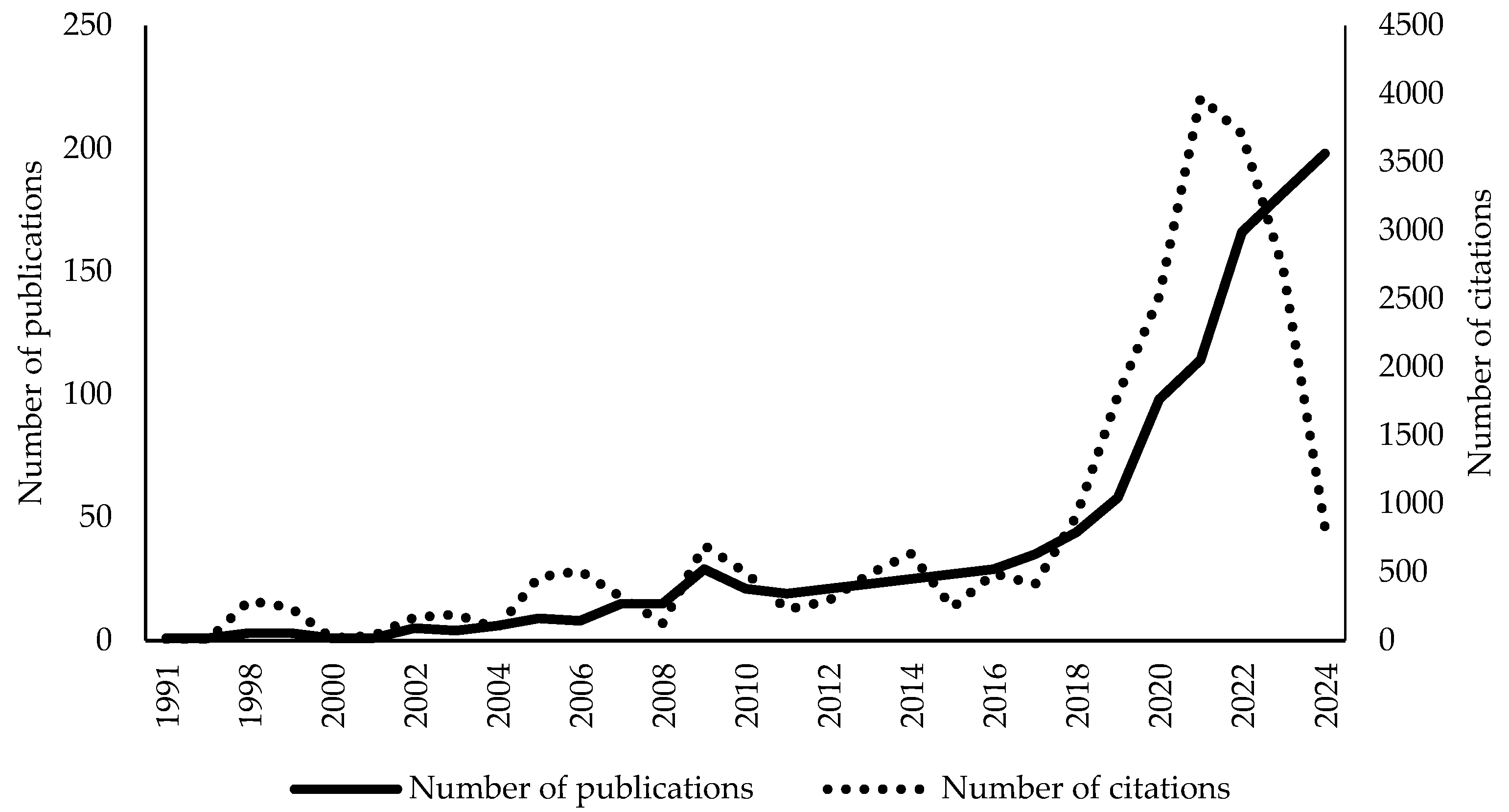
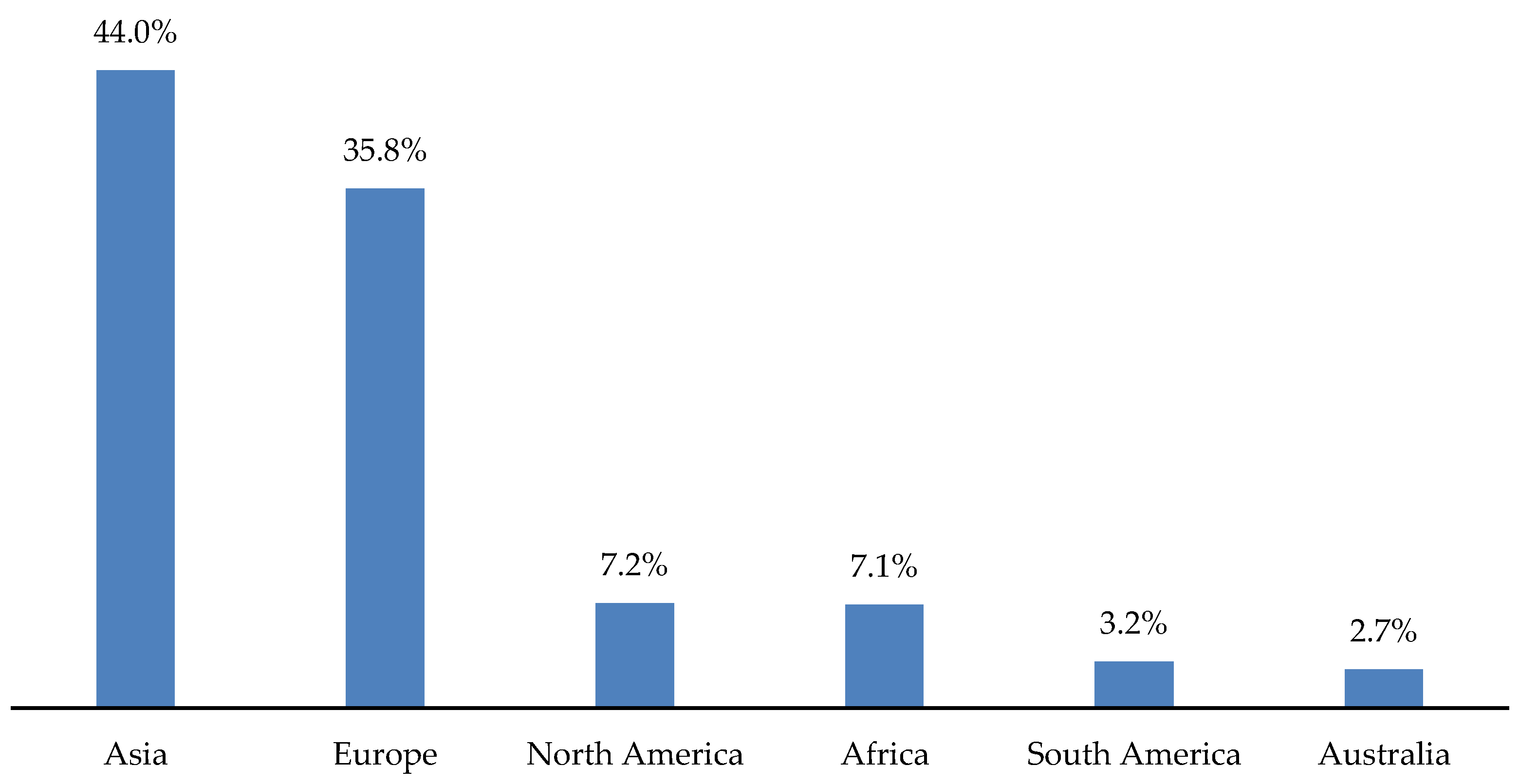
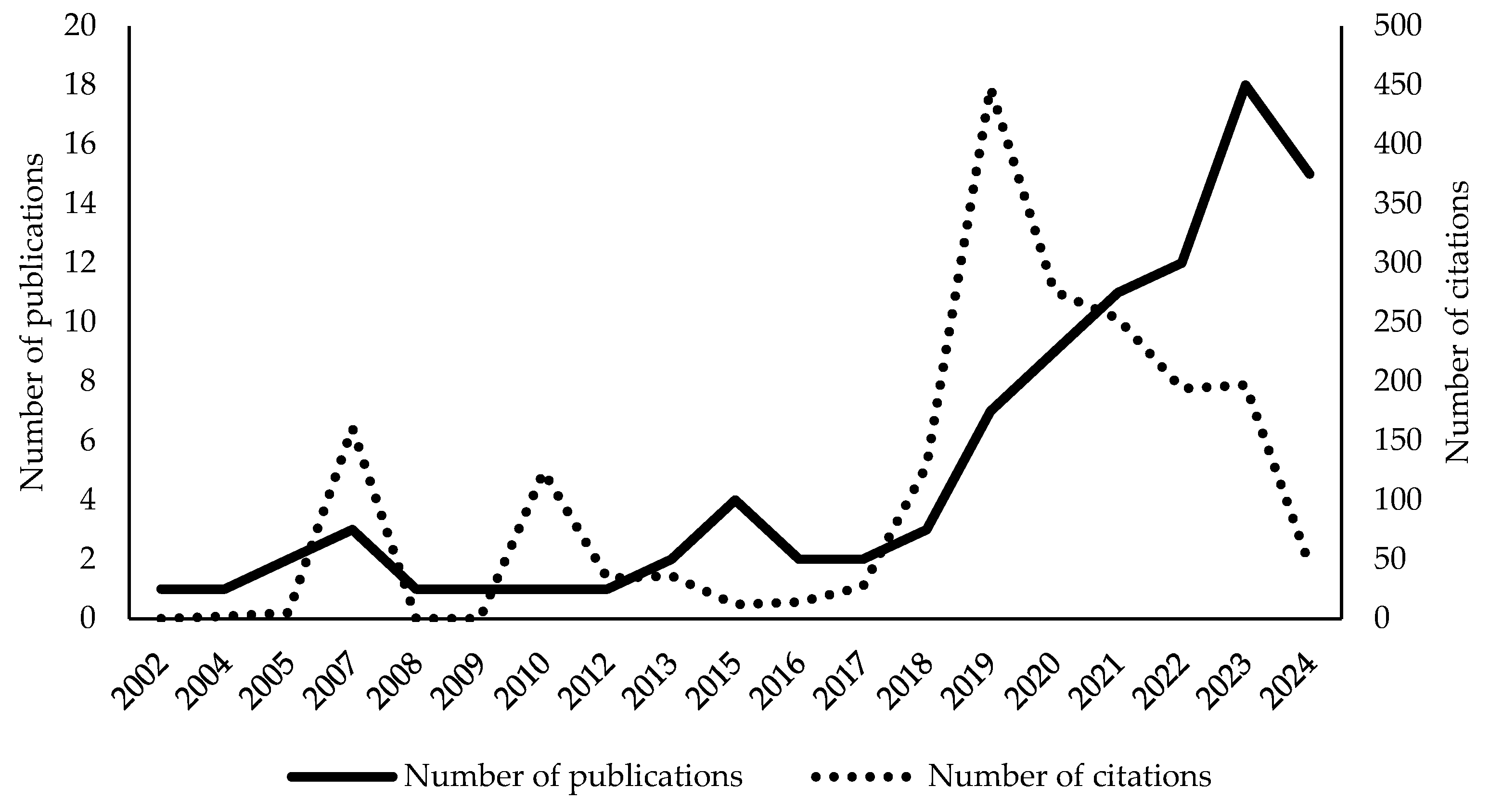
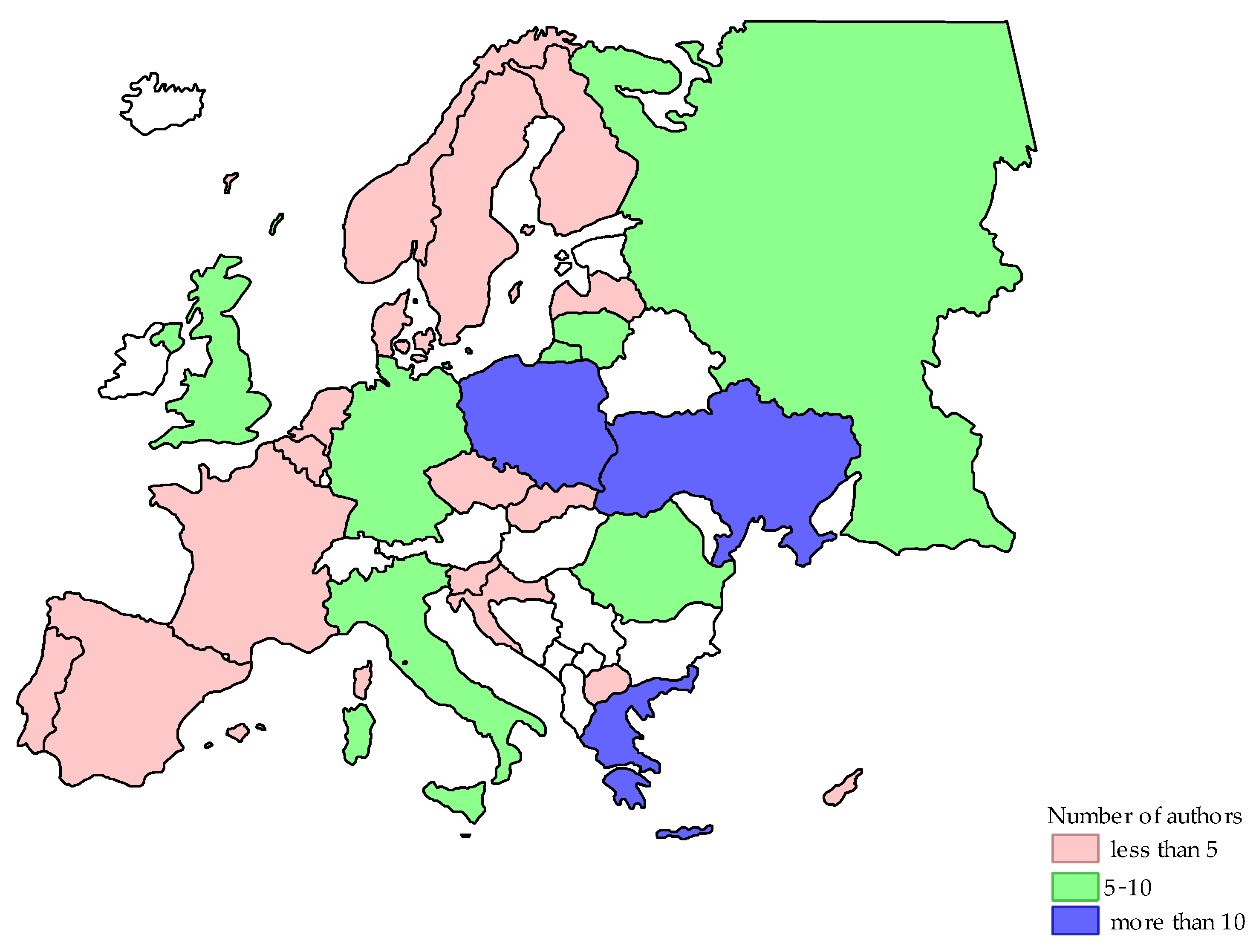
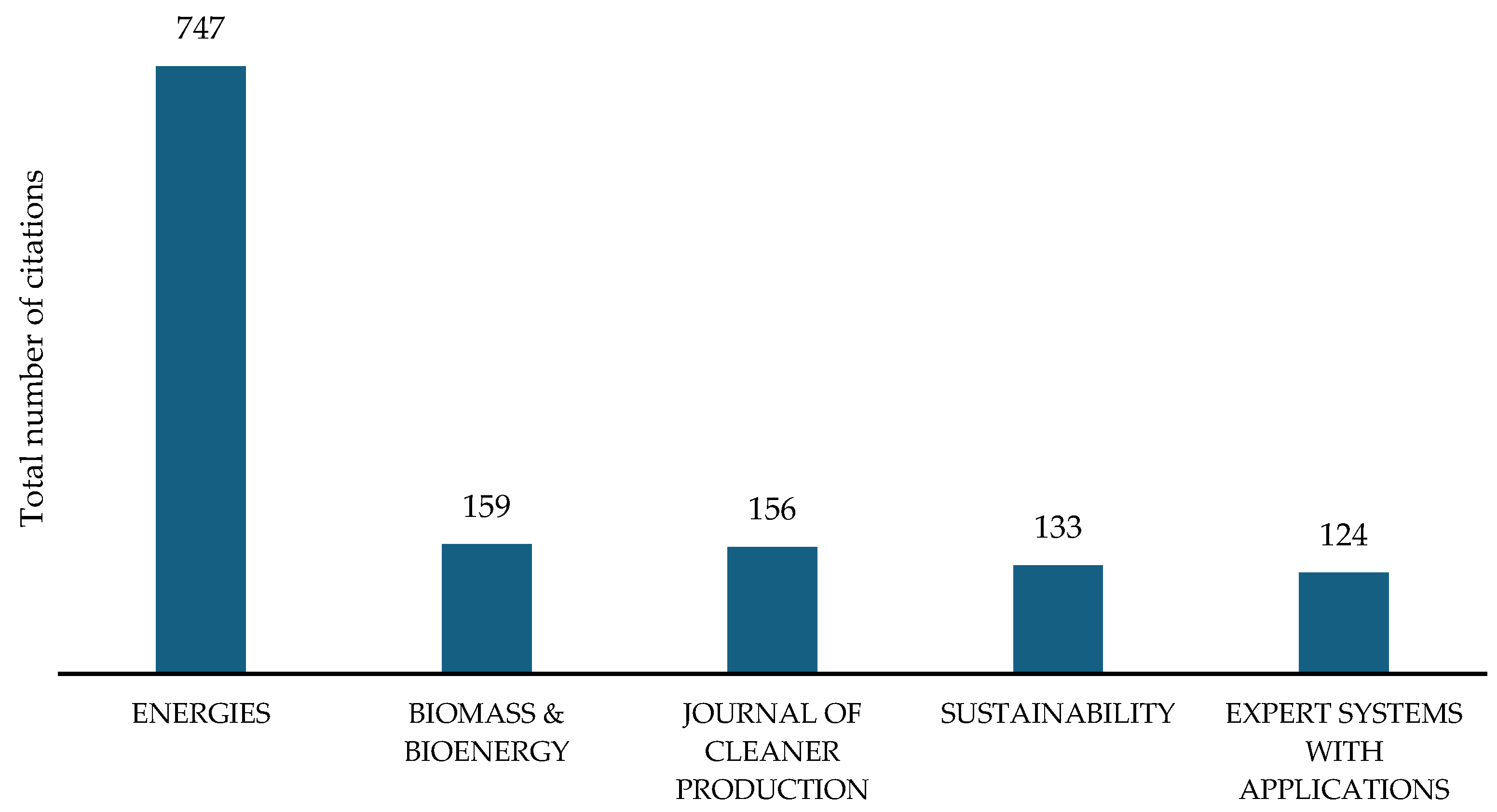
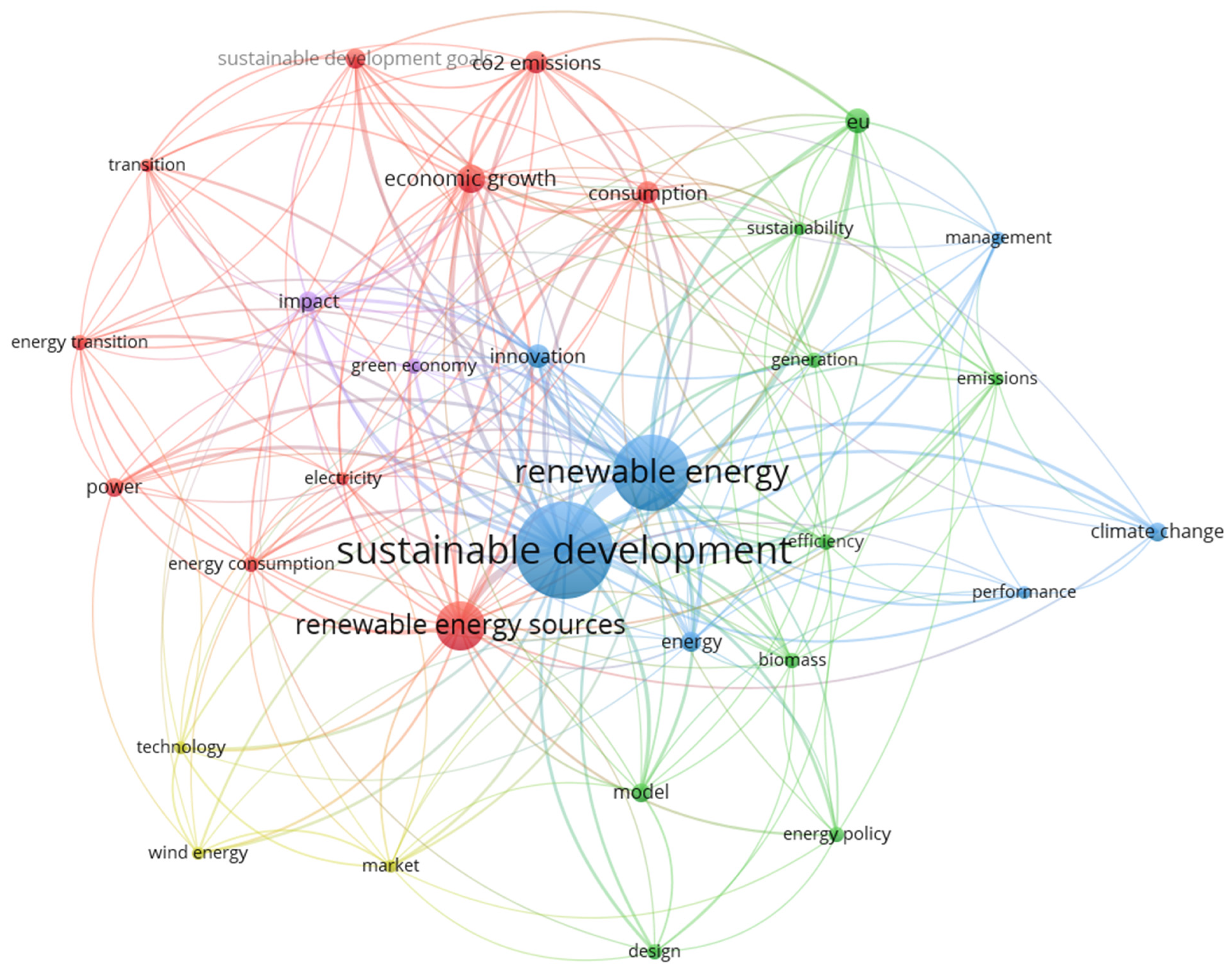
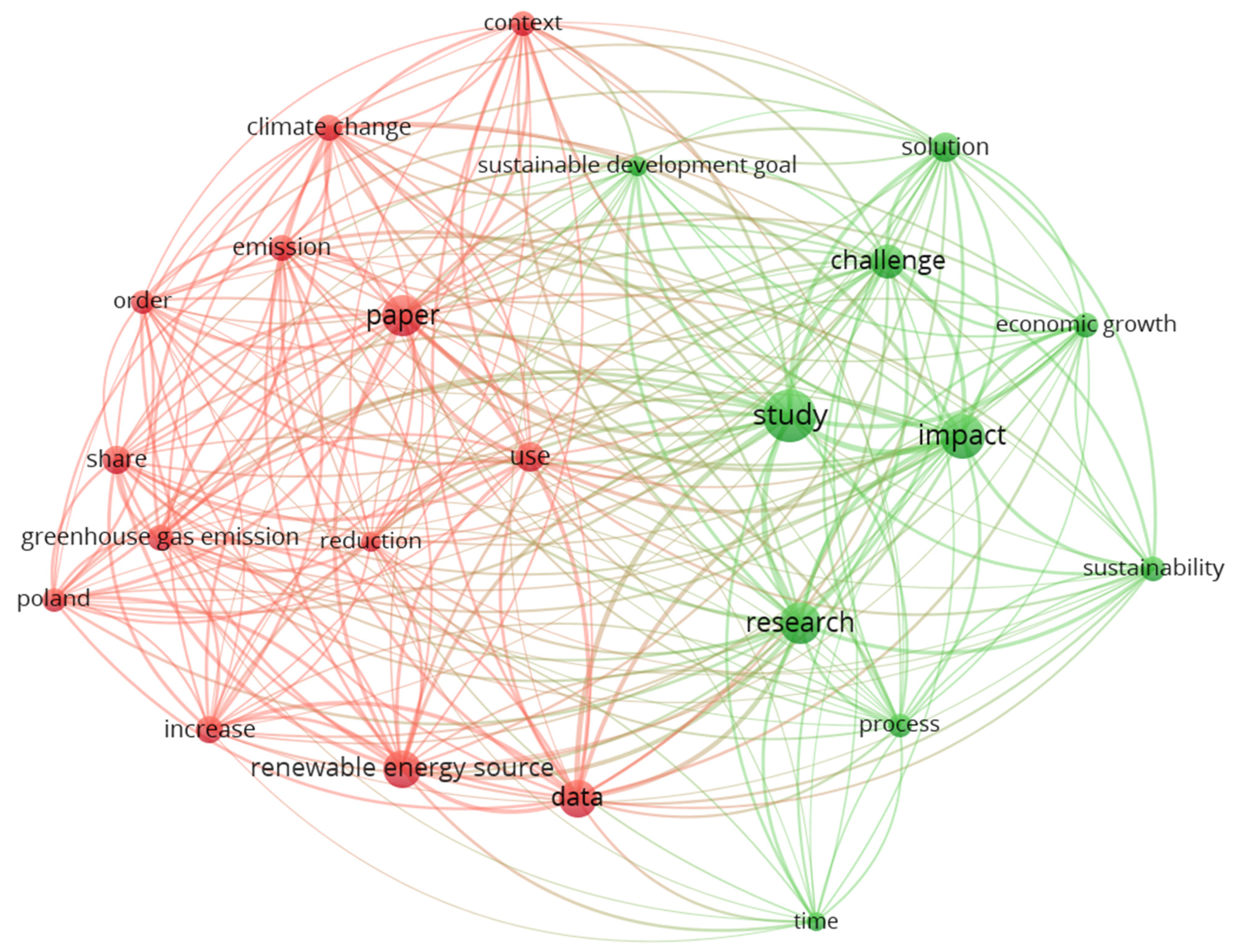

| Author | Title | Journal | Year | Citations |
|---|---|---|---|---|
| McCormick, K; Kåberger, T | Key barriers for bioenergy in Europe: Economic conditions, know-how and institutional capacity, and supply chain coordination [9] | Biomass & Bioenergy | 2007 | 159 |
| Bórawski, P; Beldycka-Bórawska, A; Szymanska, EJ; Jankowski, KJ; Dubis, B; Dunn, JW | Development of renewable energy sources market and biofuels in The European Union [10] | Journal Of Cleaner Production | 2019 | 156 |
| Lyeonov, S; Pimonenko, T; Bilan, Y; Streimikiene, D; Mentel, G | Assessment of Green Investments’ Impact on Sustainable Development: Linking Gross Domestic Product Per Capita, Greenhouse Gas Emissions and Renewable Energy [11] | Energies | 2019 | 137 |
| Vasylieva, T; Lyulyov, O; Bilan, Y; Streimikiene, D | Sustainable Economic Development and Greenhouse Gas Emissions: The Dynamic Impact of Renewable Energy Consumption, GDP, and Corruption [12] | Energies | 2019 | 134 |
| Doukas, H; Karakosta, C; Psarras, J | Computing with words to assess the sustainability of renewable energy options [13] | Expert Systems With Applications | 2010 | 124 |
| Swain, RB; Karimu, A | Renewable electricity and sustainable development goals in the EU [14] | World Development | 2020 | 108 |
| Cirstea, SD; Moldovan-Teselios, C; Cîrstea, A; Turcu, AC; Darab, CP | Evaluating Renewable Energy Sustainability by Composite Index [15] | Sustainability | 2018 | 59 |
| Guzovic, Z; Duic, N; Piacentino, A; Markovska, N; Mathiesen, BV; Lund, H | Recent advances in methods, policies and technologies at sustainable energy systems development [16] | Energy | 2022 | 59 |
| Fotis, P; Polemis, M | Sustainable development, environmental policy and renewable energy use: A dynamic panel data approach [17] | Sustainable Development | 2018 | 53 |
| Wuebben, D; Romero-Luis, J; Gertrudix, M | Citizen Science and Citizen Energy Communities: A Systematic Review and Potential Alliances for SDGs [18] | Sustainability | 2020 | 52 |
| The Main Source of Renewable Energy | Countries |
|---|---|
| Solar energy | Hungary, Czech Republic, Germany, Spain |
| Biomass | Albania, Croatia, North Macedonia, Serbia, Montenegro, Greece, Germany, Finland |
| Geothermal energy | It is not the main source of energy in EU countries. |
| Wind energy | Lithuania, Poland, Germany, Spain, Ireland, Portugal |
| Hydro energy | Albania, North Macedonia, Bosnia and Herzegovina, Latvia, Slovenia, Romania, Bulgaria, Slovakia, Finland |
| Examination of the Current State | Forecasts |
|---|---|
| D. Lalic et al. [54], L. Li et al. [22], J. Brodny et al. [24], Brodny et al. [41], E. Soares-Ramos et al. [57], Q. Wang, L. Zhan [44], D. Čeryová et al. [43], A. Shivakumar et al. [42] | T. Pakulska [49] D. Lalic et al. [54], S. Potrč et al. [58], E. Soares-Ramos et al. [57], A. Shivakumar et al. [42], R. Bointner et al. [59] |
| Barriers | Challenges |
|---|---|
Economic:
|
|
Institutional:
|
|
Infrastructural/technical:
|
|
Social:
|
|
Disclaimer/Publisher’s Note: The statements, opinions and data contained in all publications are solely those of the individual author(s) and contributor(s) and not of MDPI and/or the editor(s). MDPI and/or the editor(s) disclaim responsibility for any injury to people or property resulting from any ideas, methods, instructions or products referred to in the content. |
© 2025 by the authors. Licensee MDPI, Basel, Switzerland. This article is an open access article distributed under the terms and conditions of the Creative Commons Attribution (CC BY) license (https://creativecommons.org/licenses/by/4.0/).
Share and Cite
Bąk, I.; Wawrzyniak, K.; Barej-Kaczmarek, E.; Oesterreich, M. Renewable Energy for Sustainable Development in EU Countries: Status, Prospects, and Challenges. Energies 2025, 18, 1333. https://doi.org/10.3390/en18061333
Bąk I, Wawrzyniak K, Barej-Kaczmarek E, Oesterreich M. Renewable Energy for Sustainable Development in EU Countries: Status, Prospects, and Challenges. Energies. 2025; 18(6):1333. https://doi.org/10.3390/en18061333
Chicago/Turabian StyleBąk, Iwona, Katarzyna Wawrzyniak, Emilia Barej-Kaczmarek, and Maciej Oesterreich. 2025. "Renewable Energy for Sustainable Development in EU Countries: Status, Prospects, and Challenges" Energies 18, no. 6: 1333. https://doi.org/10.3390/en18061333
APA StyleBąk, I., Wawrzyniak, K., Barej-Kaczmarek, E., & Oesterreich, M. (2025). Renewable Energy for Sustainable Development in EU Countries: Status, Prospects, and Challenges. Energies, 18(6), 1333. https://doi.org/10.3390/en18061333






